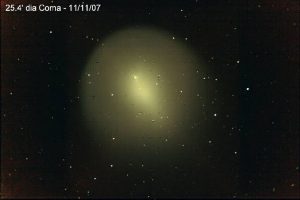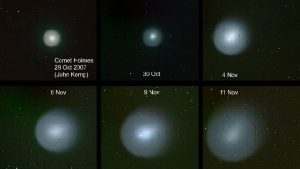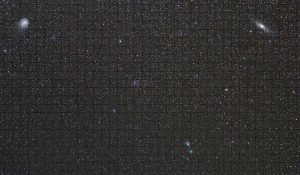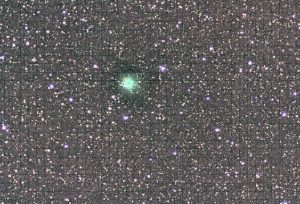I am not a comet hunter! But from reading popular astronomy books it seemed to me that the Victorians, in particular, had had more than their fair share of ‘comets of the century’ – great arcing comets that had stretched across large sections of the sky and had amazed the non-astronomers viewing them in their relatively non-light polluted city skies. And nothing like that has occurred in my lifetime. True, that Halley’s Comet in the mid-80’s had returned and I showed friends in London a view of it through my 6” f/8 Newtonian. But it was a bit of a disappointment and I quickly moved on to astounding them with views of Jupiter and the moons.
But then we had some great comets suddenly emerge in the 90’s. Firstly Comet Hyakutake in 1996 – but for some reason I forget I paid little attention to it. But it must have whetted my appetite because I really got excited when Hale-Bopp then burst onto the scene. Like many great comets of the past, high magnification views through the scope were of little benefit apart from curiosity about the nucleus. The real glory came from low mag. binocular views, simple naked eye views from dark sites and it was especially easy to snap with common cameras of the time.
As it lay in the North Sky when most spectacular I remember going a couple of times to sites north of Bath (just pulling into lay-bys or open-gated fields). Photos showed the blue gas tail clearly though this was harder to see with the naked eye. My photo shown here was taken with a 200mm telephoto on a SLR camera piggybacked onto my SCT on one of those trips north of Bath (800ASA colour transparency film). And Hale-Bopp hung around for months, so it seemed, being somewhat distant from the Earth, almost becoming a routine part of the night sky. I do remember looking at the nucleus through my 8” SCT and seeing (and photographing) a spiral pattern around the star-like nucleus. I doubted its reality until I read that it was due to gas jets emanating from a spinning nucleus.
And that was probably meant to be my ‘comet of a lifetime’ but then at the end of 2007 Comet Holmes – an innocuous rarely-seen comet, only known because it had flared up in brightness in 1892, did its brightening trick for a second (recorded) time. Within days of its reported brightening we had a look at it in the eastern sky across Queens Square, after a Herschel Friday meeting, with binoculars. It was bright enough to be seen in the centre of Bath!
I took a lot of ‘wide-field’ digital camera shots, and tried to keep track of its gradually expanding coma over the next 3-4 months.
One of my shots is at the top; beneath it is a montage produced by John Kemp, a friend of Dick Phillips.
Combining his and my photos, and measuring the coma diameter I noted the following trend in angular size (top graph):
It seems to flatten off with time (29th Oct – the first day John Kemp viewed the outburst is ‘day 0’ on the graph axis!). But over the time of the observations the distance between Holmes and the Earth changed. Using a basic planetarium program I determined the Earth-Holmes distance and converted the angular diameter of the comet to a physical diameter, which included this distance correction (lower graph). There are some ‘error bars’ as the measurement in different directions could be a touch variable.
The flattening off is less clear and seems to indicated that this distant comet’s coma, once it had exploded due to whatever caused its eruption, then expanded pretty constantly for months, presumably because of the weak pressure of the solar wind at its location.
This unusual comet didn’t come and go from the inner solar system as many do but pretty much pottered along in its inter-Mars/Jupiter orbit and faded as its sudden eruption (for unclear reasons – thermal cracking of its icy crust?) slowly dissipated.
And while Holmes was still noticeable, a regular and expected comet – Tuttle – came on the scene. Below is a shot I got off the internet from early 2008 (sorry – unattributable!) showing Tuttle (the green blob towards the bottom of the frame), Holmes (the white blob top left) and the Andromeda Galaxy (top right). Tuttle was only barely naked eye visibility but though not spectacular that is still better than most manage and I was now ‘in the groove’ looking at them!
In the shot below (one of my own) I have tracked the stars during several 30s exposures then combined so the fixed stars are overlaid. But each image of the comet (green) doesn’t overlay as it was moving so fast across the sky during the course of the few minutes it took to take this sequence!
The green glow itself is apparently due to the dominant molecules fluorescing in its coma – mainly various simple organic molecules such as CH.
And my last Comet Tuttle shot – heavily exposed to look for a tail (I couldn’t see one) also shows something else that can divert your attention when star-gazing – man made satellites!
If you look carefully there is one streak almost going through the comet and another above it and another below (fainter). I hope the image reproduces well enough to show these! Again I took several consecutive images and overlaid them – the satellite tracks were present in only a few of them. Curious as to what these relatively slow tracks were I posted a query on a ‘satellite specialists’ internet site and was told that these slower tracks obviously weren’t distant geosynchronous satellites, nor fast enough to be in low earth orbit (like the International Space Station) but either unusual elliptical orbit satellites or stages from old rockets in similar orbits. In fact one of my contacts identified one as a 15-year-old Centaur rocket stage! They are apparently well catalogued by these guys interested in satellites!
So a diversion from the great comets we’ve seen in recent years but interesting nonetheless. No bright and expected periodic comets are expected any time soon. But maybe another unexpected one will turn up soon as it did so frequently for the Victorians. But maybe I’m being greedy.
Have any others of you some comet tales of your own? Tell us about them in the chat forum…









